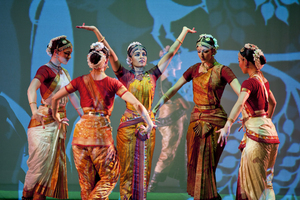Ragamala Dance casts an artful spell in Power Center performance

Ragamala Dance publicity photo
photo by Hub Wilson
The dancers of Ragamala, directed by 2 of the 6, mother and daughter Ranee and Aparna Ramaswamy, who also choreographed “Sacred Earth,” dance with every fiber of their bodies, from the top down and to the tips of their fingers. Eyes dart, teeth flash, bells jangle at their ankles, feet and hands are tinted red to read all the more vividly.
They are pictures of grace and balance, centered and upright, but also supple in their movement. And they dance in harmony with, well “Sacred Earth,” revealed here through Tamil poetry, tribal Indian art and live music.
Bharatanatyam is traditionally a solo art, but in “Sacred Earth” the Ramaswamys artfully employ an ensemble—not just to echo and amplify the movements of soloists (the two of them plus Ashwini Ramaswamy and Tamara Nadel), but to mesmerize through unison movement and accumulation of gestures.
In the opening, the ensemble circles Ranee Ramaswamy, rice powder streaming from their outstretched hands as she crouches at their center, making a rice-powder design on the floor, an offering to Mother Earth. It would have been nice to see that pattern projected on the backdrop, but what is there instead—projections of chalked wall paintings commissioned from a Warli artist from western India, Anil Chaitya Vangad —seems the very incarnation of the dance’s theme of harmony between the elements of nature and all who inhabit it, human and animal.
Stick-figure humans spiral across the space in expanding arcs at the dance’s beginning. Trees of life spring up, monkeys climb them; rivers flow, fish swim; horses graze and are groomed; birds nest among grasses and whole villages materialize against smoke and mauve skies.
The dancers bring these pictures—and those of the poems, with their metaphors of love and nature—to life in narrative sections of the dance; the excellent musicians (Lalit Subramanian, Suchitra Sairam, Rajna Swaminathan and Anjna Swaminathan) contribute their voices with expressive melismatic singing, and with violin, tabla and cymbals. They follow and lead and call out the rhythms in the animated pure-dance sections that showcase the dancers’ technical skills.
Aparna Ramaswamy made a particularly strong impression with her vivacity and precision and musicality, but all the dancers—as befits a dance about harmony—worked together with a sort of luminous sympathy that was itself a meditation.


Comments
BhavanaJagat
Fri, Apr 26, 2013 : 6:38 p.m.
Spiritualism - The Colors of Life: Color plays an important role in every aspect of life. No single function can explain the coloration of living things. Human civilization has developed taste in color and has attached values and functions to the colors it visualizes. A sense of fitness has been acquired concerning the use of color. The story reads that "it is autumn for the six women dancers on the stage." In India, saffron or subdued orange represents courage, sacrifice, and the spirit of renunciation. Green stands for fertility, prosperity, and faith. Mother Earth while being brown or rusty generates the hues such as gold that represents succor, and green that represents life. It is a pleasure to read about the performance.